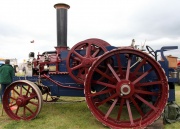Richard Hornsby and Sons: Hornsby-Akroyd

















Note: This is a sub-section of Richard Hornsby and Sons
1890 Herbert Akroyd Stuart and Charles Richard Binney patented the world's first compression ignition engine. The system described is known as solid injection; it is the principle that is used by most present day diesel engines and was a proven technique when Rudolph Diesel presented his designs for a patent in 1893.
Several experimental engines were built at the Stuart's Bletchley factory, one of which was installed at the newspaper offices of the Fenny Stratford Times; another went to the waterworks and a third to the brush factory of Messrs. Cooks. As the quality of the engineering on these engines was poor, George Wailes and Co, Euston Road, London built a subsequent batch of four. Unfortunately there are no known survivors of these early engines.
By 1891, Akroyd-Stuart realised that the engine was ready for quantity production and Richard Hornsby and Sons, at Grantham, was offered the manufacturing rights to develop and market the Hornsby-Akroyd engine. Two of the Akroyd designed engines were subsequently exhibited by Hornsbys at the Royal Agricultural Show, held at Doncaster in June 1891.
In May 1892 the first production engines, numbers 101 and 102, were installed at the Great Brickhill Waterworks, at Fenny Stratford. The engines worked regularly until 1923, when a Mr. Evans, a timber merchant in Bletchley, purchased No. 101. In 1939 the engine was returned to Hornsby's where it was restored and preserved as a museum piece. Today it is displayed in the works of MAN B&W Diesel Ltd, Ruston, at Newton-le-Willows, Merseyside.
The Hornsby-Akroyd was an instant success and a total of 32,417 engines of this type were built. Its uses were numerous; the engines were produced in both horizontal and vertical form, stationary and portable.
1896 this type of engine was used to power the first oil tractor and the first oil locomotive.
1897 Hornsby-Akroyd Oil Engine exhibited at the Royal Show and won Silver. This had a 20 hp single cylinder 14.5 inch diameter, was 3-speed, weighed 8.5 ton and cost £500 when new
1905 A 20 h.p. Hornsby-Akroyd engined tractor was the worlds first 'caterpillar' tractor.
See Also
Sources of Information

